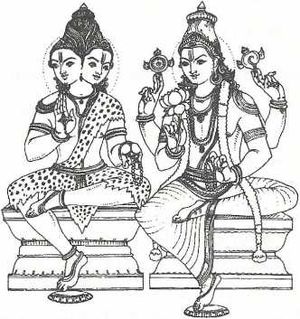Nara-Nārāyaṇa
By Swami Harshananda
Origin of Nara-Nārāyaṇa Form[edit]
After the purpose of Narasimha-avatāra was accomplished, Narasimha split himself into two, the lion part becoming the sage Nārāyaṇa and the human part the sage Nara. Nara and Nārāyaṇa then retired to Badarikāśrama for performing austerities. When Indra tried to seduce them through celestial nymphs, Nārāyaṇa produced the nymph Urvaśī from his thigh[1] who was more beautiful than all of them put together.
Other Belief Regarding the Origin[edit]
According to another version, these sages were sons of Dharma and Ahinsā (also called Kala and Murti.) They performed severe austerities and successfully vanquished the demon Sahasrakavaca.[2] These sages were reborn later as Śrī Kṛṣṇan and Arjuna. This story has an important lesson for us. Every one of us is a mixture of the human and the divine elements. The anti-human and the anti-divine demon is ever attempting to seduce us with his thousand wiles. To successfully vanquish him, we need to perform Tapas or austerity.
Representation of Nara-Nārāyaṇa[edit]
Nara-Nārāyaṇa is represented either as a single person or as two persons. In the former case, the icon may have two or four arms carrying the japamālā[3] or the usual emblems of Lord Viṣṇu. In the latter case, Nara may be shown as having two heads and two arms and wearing the deer skin. Nārāyaṇa is depicted with the usual four arms carrying the emblems śaṅkha, cakra, padma and japamālā.
References[edit]
- The Concise Encyclopedia of Hinduism, Swami Harshananda, Ram Krishna Math, Bangalore

